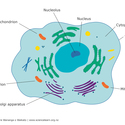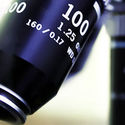Taking a closer look at our world
Microscopes let us view an invisible world – the objects around us that are too small to be seen with the naked eye. Learn more about how microscopes work and how they can shed light on plant structure, cells, earthquake processes and more.
This resource provides explanations of the key concepts encountered when exploring with microscopes – the ‘basics’ that every student should understand.
Optical microscope
An optical microscope1 (or light microscope2) uses visible light (400–700 nm) to illuminate the object being viewed (the sample). In most cases, this is white light, but in confocal laser scanning fluorescence3 microscopy, samples are illuminated with lasers, which provide coloured light of a single, defined wavelength4. Before the 1930s, optical microscopes were the only microscopes in existence.
Electron microscope
Electron microscopes5 use a focused beam of electrons (rather than visible light) to illuminate the object being viewed (the sample). The electron6 beam is focused by means of electromagnetic coils (rather than the glass lenses found in optical microscopes). The small wavelength of the electron beam means that electron microscopes are capable of visualising samples at very high resolution7.
Lens
The term ‘lens’ traditionally refers to a piece of glass (or other transparent8 material) that is curved on at least one side and is used to focus or disperse light. Optical microscopes use biconvex9 lenses (curved outwards on both sides) to focus light. The electromagnetic coils within electron microscopes are also sometimes referred to as lenses because of their role in focusing the electron beam.
Micrograph
A digital image or photograph that represents the view through a microscope10. Many modern microscopes are integrated with computer systems that show the user the microscope image on a screen. ‘Snapshots’ of these digital images are micrographs.
Resolution
In microscopy and other forms of imaging, resolution is the ability to distinguish two separate points or objects as independent. In practice, resolution is a measure of the degree of detail that can be seen in a sample. Resolution is distinct from magnification, which means making an object bigger, but does not imply any increase in detail.
Artefact
Artefacts are phenomena that are not naturally present in a sample but have instead been introduced as a result of experimental procedure. Artefacts are commonly introduced during preparation of specimens for microscopy and are a particular issue for electron microscopy because of the complex preparation procedures involved.
- optical microscope: A microscope that uses a glass lens (or lenses) to magnify small objects that are illuminated with visible light.
- light microscope: A microscope that uses a glass lens (or lenses) to magnify small objects that are illuminated with visible light.
- fluorescence: The giving out of light when atoms are excited by an external energy source, such as light (but not heat).
- wavelength: The distance between two successive points of a wave (from one peak or crest of a wave and the next peak or crest). Usually refers to an electromagnetic wave, measured in nanometres (nm).
- electron microscope: A microscope that uses a focused beam of electrons, rather than visible light, to magnify objects. Electron microscopes use electromagnetic coils to focus the electron beam (instead of the glass lenses used to focus light in optical microscopes). Traditional light microscopes magnify images 1000-2000 times, electron microscopes can magnify 300,000 times or more.
- electron: A light subatomic particle with negative charge, found in the space surrounding an atomic nucleus.
- resolution: In microscopy, the ability to distinguish two separate points or objects as independent. The resolution of a microscope provides a measure of the level of detail it can be used to reveal. In an image, the degree of sharpness. Resolution is measured by the number of dots per linear inch in a hard-copy printout, and the number of pixels on a display screen.
- transparent: A substance that light can pass through without scattering. Objects are clearly visible when viewed through a transparent substance such as smooth window glass or water.
- biconvex: A lens in which both surfaces curve outwards.
- microscope: An instrument that uses a lens or a series of lenses to magnify small objects.


